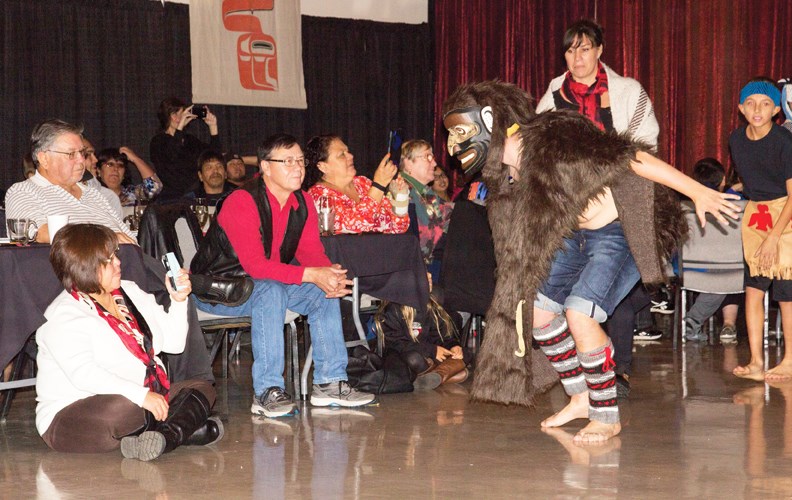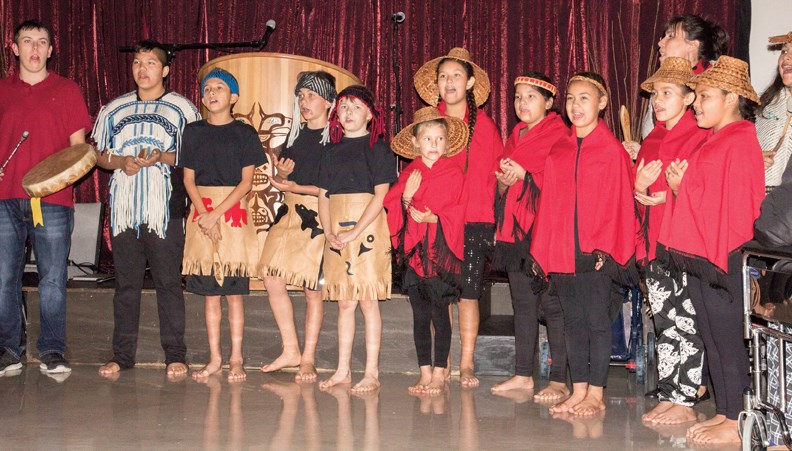The shíshálh community gathered together to celebrate the shíshálh Nation’s 30 years of self-government at the Sechelt Indian Band community hall on Oct. 15.
Guests were welcomed with performances by the tl’ikw’am Dance Group – with instructors Rita Poulsen, Leah Julius, Andy Johnson and Kristi Haavisto – from Kinnikinnick Elementary.
“Tl’ikw’am means Kinnikinnick berry or bear berry in our language,” cultural interpreter Raquel Joe said. “They teach the children our beautiful language, our exquisite and unique culture and protocol of the longhouse way. Landon Dixon, our youth leader, leads the dances with the boys. They practise the routines on their own time up at the school. They are very dedicated to our youth.”
Dinner featuring main courses of salmon and cod was served to the elders first, then to the rest of the 150 or so guests.
While everyone ate, they were shown a video of historical footage beginning in the early 1980s of the shíshálh chiefs who were involved in the arduous process of establishing a self-government.

Chief Calvin Craigan, the first speaker to address the gathering, began by acknowledging the work that began over 30 years ago – and continues today – to ensure an independent nation for the shíshálh people.
“We’re all relatives and we are all here to celebrate the vision of our forefathers,” Craigan said. “It’s been already 30 years since the old chiefs had the vision to be independent once again.… They wanted to challenge the governments that had taken away and stolen a way of life from the shíshálh people. When I say they stole a way of life, they took us from our land, they took us from all of our resources and made us dependent on the government.
“That was a violation that the old chiefs would not forgive, because they had so much pride in what they had done, so much pride in the way of life that they left. They lived a life in harmony, not only with the land but with one another,” Craigan said. “The way they governed themselves within the land was in harmony with one another.”
Many who spoke at the celebration said that they saw a bright future for the shíshálh Nation.
“I really enjoyed seeing our children dancing today, and I’m grateful to be here,” director of resource management Sid Quinn said. “I look forward to our future.”
Quinn asked that everyone take a moment of silence for the ancestors. “They’re the reason why we’re here today,” he said.
“I look around and I see nothing but youth, I see the future and it looks good,” former councillor Warren Paull said. “We’ve come through some pretty tough times in our last 30 years since we did the self-government march. There was a lot of hard effort that was put into it.”
Paull served his first term on council when the Sechelt Indian Band Self-Government Act was signed in 1986.
“It’s a great and wonderful thing to see us here celebrating 30 years – we’ve come a long way,” Paull said. “We’ve got an administration that’s ready and poised to take the next step in asserting our governance over our territory. We’ve got the Tsilhqot’in decision, which is now looking like it’s going to be the definitive process for us to follow, for us to make our way and give us guidance for how we’re going to develop our next step. It all looks really good, it looks promising.”
The Tsilhqot’in decision refers to the Supreme Court of Canada ruling that recognized Aboriginal title to a specific tract of land. The unanimous decision made in 2014 ended a 25-year legal battle and set an historic precedent affecting resource rights.
“Thirty years is a short time – three decades – but we’ve been here for thousands of years. Some say, even since time immemorial,” shíshálh Nation councillor Robert Joe said. “We have an historical, cultural, moral, social and economic connection to our land. Our land is 515,000 hectares. I’m proud to say that. Under the self-government, we have 1,000 hectares – 33 parcels of land. I want you to know that.
“The federal government and provincial government have taken away our land, they’ve taken away our culture, they’ve taken away our heritage,” Joe said. “We’re fighting to get that back and we’re getting that back through our stories and our elders.”
“I think we’re slowly achieving the vision of the forefathers,” Craigan said in an interview after the celebration. “They wanted to reclaim their independence and they slowly devised how they would do that. They slowly put together the visions about documenting a constitution that would allow us to do that.
“Even in the day – during the 1960s – the old chiefs recognized that we were up against two governments. They understood that even though we got to a point where we would almost achieve independence, there would be laws made, there would be regulations made to prevent us from doing that.
“They understood that so they started to capacity build even in those days. Many of the young chiefs in the film we saw were trained in a special way. Chief Tommy Paul, he was trained to understand numbers so he became kind of a bookkeeper or accountant.
“In my case,” Craigan said, “I was sent away to learn and understand land values. Many of the young chiefs were trained in a special way to start building capacity that would put together a government, so that we would be able to not only rule but govern ourselves, our land and our resources.”
The process may be slow, but like Quinn and Paull, Craigan also said he saw a bright future for the shíshálh.
“The future is not only bright but it’s very encouraging,” Craigan said. “Not only will our people have the pride and the jurisdiction and authority and the right to govern themselves again, but they’re stepping into a place where they’re bringing more capacity and more education.
“We have many students who are finishing in business law, business administration. We have young women in UBC taking environmental programs. All of those people are going to be coming back into this life within the next two years. Some of them are going to be lawyers, some of them are becoming lawyers now. The dream of our people is coming true.
“I think those young people will get to understand and recognize that they’re going to be setting the next stage for governing the affairs of our people. It’s going to be a promising land, it’s going to be encouraging – not only for young people, but they have to understand that they now have that responsibility as us old chiefs disappear,” Craigan said. “We set the table, we set the goals, we set the vision. Now it’s up to them to complete it.”



